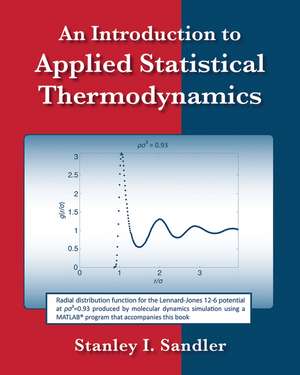An Introduction to Applied Statistical Thermodynaics
Autor SI Sandleren Limba Engleză Paperback – 9 dec 2010
Preț: 831.60 lei
Preț vechi: 1272.00 lei
-35% Nou
Puncte Express: 1247
Preț estimativ în valută:
159.17€ • 165.54$ • 133.38£
159.17€ • 165.54$ • 133.38£
Carte indisponibilă temporar
Doresc să fiu notificat când acest titlu va fi disponibil:
Se trimite...
Preluare comenzi: 021 569.72.76
Specificații
ISBN-13: 9780470913475
ISBN-10: 0470913479
Pagini: 368
Dimensiuni: 204 x 251 x 14 mm
Greutate: 0.59 kg
Editura: Wiley
Locul publicării:Hoboken, United States
ISBN-10: 0470913479
Pagini: 368
Dimensiuni: 204 x 251 x 14 mm
Greutate: 0.59 kg
Editura: Wiley
Locul publicării:Hoboken, United States
Public țintă
Engineers and Students and Instructors of Engineering.Cuprins
Notă biografică
STANLEY I. SANDLER is the H. B. du Pont Professor of Chemical Engineering at the University of Delaware as well as professor of chemistry and biochemistry. He is also the founding director of its Center for Molecular and Engineering Thermodynamics. In addition to this book, Sandler is the author of 235 research papers and a monograph, and is the editor of a book on thermodynamic modeling and five conference proceedings. He earned his B.Ch.E. degree in 1962 from the City College of New York, and his Ph.D. in chemical engineering from the University of Minnesota in 1966.
